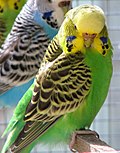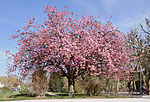 | Biological pigments, also known simply as pigments or biochromes, are substances produced by living organisms that have a color resulting from selective... 32 KB (3,908 words) - 20:24, 18 April 2024 |
 | A pigment is a powder used to add color or change visual appearance. Pigments are completely or nearly insoluble and chemically unreactive in water or... 34 KB (3,077 words) - 15:22, 13 February 2024 |
Photopigment (category Pigments) responsible for visual perception, but also melanopsin and others. Biological pigment Epstein, R.J. (2003). Human Molecular Biology: An Introduction to... 3 KB (328 words) - 02:33, 16 July 2021 |
 | Anthocyanin (redirect from Production of Anthocyanin Pigment 1) (kuáneos/kuanoûs) 'dark blue'), also called anthocyans, are water-soluble vacuolar pigments that, depending on their pH, may appear red, purple, blue, or black. In... 47 KB (4,582 words) - 04:33, 18 April 2024 |
 | Phenylalanine (section Other biological roles) norepinephrine (noradrenaline), and epinephrine (adrenaline), and the biological pigment melanin. It is encoded by the messenger RNA codons UUU and UUC. Phenylalanine... 28 KB (2,386 words) - 16:28, 30 March 2024 |
Carmine (category Biological pigments) lake – is a pigment of a bright-red color obtained from the aluminium complex derived from carminic acid. Specific code names for the pigment include natural... 23 KB (2,469 words) - 17:57, 28 March 2024 |
 | Albinism (redirect from Albinism, minimal pigment type) that are not absorbed by the pigment, but instead are reflected. Biological pigments include plant pigments and flower pigments. Animals can appear coloured... 73 KB (8,242 words) - 16:34, 3 April 2024 |
A respiratory pigment is a metalloprotein that serves a variety of important functions, its main being O2 transport. Other functions performed include... 10 KB (1,054 words) - 11:17, 18 August 2023 |
 | Bilin (biochemistry) (redirect from Bile pigment) Bilins, bilanes or bile pigments are biological pigments formed in many organisms as a metabolic product of certain porphyrins. Bilin (also called bilichrome)... 8 KB (954 words) - 21:07, 8 November 2023 |
 | Dragon's blood (category Biological pigments) been in continuous use since ancient times as varnish, medicine, incense, pigment, and dye. A great degree of confusion existed for the ancients in regard... 13 KB (1,528 words) - 08:36, 22 April 2024 |
 | Phytochrome (category Biological pigments) production of light-protective pigments, however in Synechocystis and Agrobacterium the biological function of these pigments is still unknown. In 2005, the... 22 KB (2,831 words) - 22:04, 12 February 2024 |
Ultra-Black (category Biological pigments) Oneirodes, also tied some species of birds-of-paradise as having the darkest pigment in any animal, reflecting only 0.044% of the light that hit it. This ultra-black... 6 KB (742 words) - 00:57, 27 February 2024 |
Photoreceptor protein (redirect from Photosensitive pigment) R. (2001-04-13). "Blue Light Sensing in Higher Plants *". Journal of Biological Chemistry. 276 (15): 11457–11460. doi:10.1074/jbc.R100004200. ISSN 0021-9258... 8 KB (770 words) - 18:35, 10 May 2023 |
 | Rose madder (category Biological pigments) (also known as madder) is a red paint made from the pigment madder lake, a traditional lake pigment extracted from the common madder plant Rubia tinctorum... 12 KB (1,335 words) - 18:24, 24 January 2024 |
 | Bilirubin (category Biological pigments) Bilirubin is structurally similar to the pigment phycobilin used by certain algae to capture light energy, and to the pigment phytochrome used by plants to sense... 51 KB (5,322 words) - 11:53, 12 April 2024 |
Chromoprotein (category Biological pigments) A chromoprotein is a conjugated protein that contains a pigmented prosthetic group (or cofactor). A common example is haemoglobin, which contains a heme... 5 KB (638 words) - 11:21, 3 December 2023 |
 | Basics of blue flower colouration (category Biological pigments) class metabolites. We can diversify three main classes of anthocyanin pigments: cyaniding type (two hydroxyl groups in the B-ring) responsible for red... 20 KB (2,429 words) - 04:02, 25 December 2023 |
 | Biliverdin (category Biological pigments) green bile) is a green tetrapyrrolic bile pigment, and is a product of heme catabolism. It is the pigment responsible for a greenish color sometimes... 15 KB (1,398 words) - 08:01, 31 January 2024 |
Ommochrome (redirect from Visual Pigment) Ommochrome (or visual pigment) refers to several biological pigments that occur in the eyes of crustaceans and insects. The eye color is determined by... 2 KB (248 words) - 09:40, 3 January 2023 |
 | Biology (redirect from Biological phenomenon) step of photosynthesis whereby light energy is absorbed by chlorophyll pigments attached to proteins in the thylakoid membranes. The absorbed light energy... 132 KB (13,782 words) - 20:16, 28 April 2024 |
Hematochrome is a yellow, orange, or (most commonly) red biological pigment present in some green algae, especially when exposed to intense light. It is... 1 KB (95 words) - 09:09, 9 March 2020 |
 | Turacin (category Biological pigments) Turacin is a naturally occurring red pigment that is 6% copper complexed to uroporphyrin III. Arthur Herbert Church discovered turacin in 1869. It is... 1 KB (140 words) - 23:46, 16 April 2020 |
 | and storing pigments and other important chemical compounds used by the cells of autotrophic eukaryotes. Some contain biological pigments such as used... 29 KB (3,233 words) - 15:20, 29 April 2024 |
Phototropin (category Biological pigments) Phototropins are photoreceptor proteins (more specifically, flavoproteins) that mediate phototropism responses in various species of algae, fungi and higher... 4 KB (496 words) - 14:25, 15 May 2023 |
 | Prodigiosin (category Biological pigments) phosphate conditions, pigmented strains have been shown to grow to a higher density than unpigmented strains. The ability of pigmented strains of Serratia... 14 KB (1,405 words) - 14:27, 24 March 2024 |
 | Neuromelanin (category Biological pigments) Neuromelanin (NM) is a dark pigment found in the brain which is structurally related to melanin. It is a polymer of 5,6-dihydroxyindole monomers. Neuromelanin... 8 KB (845 words) - 16:44, 25 March 2024 |



